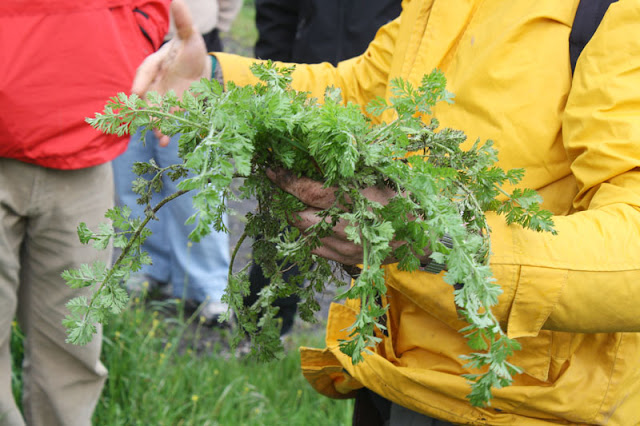On Sunday, rain or shine, Andy and I decided to try something a little different: see what culinary adventures lay in our Portland backyard.
John Kallas, Ph.D., runs an entrepreneurial business called Wild Food Adventures, and he specializes in wild edibles. Not just plants, also clams and fungi. So, on a beautiful Portland day, we met Mr. Kallas at Jessup Bluff off of N. Willamette Boulevard to see what sort of yummies we had been missing.
 |
| A beautiful Portland day |
 |
| Only in the PNW is this normal |
I wasn't sure what, exactly, I expected to get out of this workshop, but John Kallas clearly knows his stuff. He understands the plants he is looking at from germination to death and challenges students to do the same. He's practical, not flashy, and says if you're trying to entertain other people by suddenly becoming a wild food expert, you're likely to kill yourself. He encourages a practiced eye and a hands on, long term, studied approach.
Smart man.
I never knew the flowers of Broad Leaf Maple were edible. Actually, I didn't know that Broad Leaf Maple even flowered. And native, wild Fairy Bells produce a fruit after the flowering stage is finished that tastes (according to John) somewhere between a cucumber and a watermelon.
 |
| Let there be fruit....sometime |
 |
| Those whirly gig things were once edible flowers |
We dug up wild carrot first. I won't bore you with all the gory details, but Wild Carrot is the plant most likely to be confused with Poison Hemlock. This is not really a mistake you want to commit. Wild carrots are tiny, and fibrous and smell like... carrot. They are also white. Less inbreeding to produce rampant amounts of beta-carotene, I guess. Once we took a good look at Poison Hemlock (and we have loads of the stuff here, it loves this climate), I can see how people could mistake the two. The leafy greens and the root are similar in appearance if you aren't carefully looking for differentiating characteristics.
 |
| Wild Carrot greens |
Wild Sweet Pea- delicious. The new leaf buds were sweet, tasting similar to a snap pea. The flowers are also edible.
 |
| Wild Sweet Pea is hiding |
Himalayan Blackberry- if you peel the outside layer, you can eat the inside. He didn't laud them as palatable, and they certainly aren't. Just meant if there's nothing else around. And we have plenty of Himalayan Blackberry. I spit it out after one chew and said, "Yeah. If I'm starving."
Next up, Wild Fennel. Watching Andy eat that was about as entertaining as it gets. Even store-bought anise is an acquired taste in my opinion- eating the leafy tops of its wild cousin is an experience on the taste buds. We looked for young growth, as older growth acquires a rubbery texture. Another difference? No edible bulb to dip in olive oil and salt like the Italians.
Chicory- the first thing that came to mind when I saw it was the hours of the Oregon Trail computer game Andy and I used to play during our college years. We often killed our computer selves gathering the non-edibles by accident, which did not include chicory. If we gathered chicory, we lived another day. So, I was familiar with it. Similar to a dandelion but with some distinct characteristics, including, on most leaves, a pronounced curl. Very bitter, but I could see potential in a salad or stir-fry.
 |
| Gathering up some Chicory, next to Wild Carrot |
From here, we meandered across Jessup Bluff's hillside eating Garlic Mustard (tastes like garlic and is wicked, brutally invasive in the Pacific Northwest), Wild Mustard Greens, Salsify (known as goat's beard), Mint, and Curly-leaved and Broad-leaved Dock Sorrel.
Oddly, the Garlic Mustard was one of my favorites. The leaves have a nice, slightly spicy taste profile but weren't bitter, and the flowers themselves were garlicky. Maybe I can contribute to invasive species control by eating Garlic Mustard out of the Pacific Northwest.
Andy and I both agree that the Salsify was delicious. The new leaf buds have a sweet, grass-like flavor. John warned us that Curly and Broad-leaved Docks often take on an 'astringent' note when eaten raw. Andy promptly spit it out and declared it 'Listerine' (and not of the Winter Mint variety). However, according to John, the dock plants are wondrous and creamy when cooked. I'm thinking, collards? We'll see.
 |
| Andy's 'Listerine' aka Curly Leaved Dock |
We passed through a field of mint, and now I know where I'm getting my mojitos from during the summer.
At about 3:00, Andy mentioned something about grilled cheese. Unfortunately, there were no wild grilled cheeses out there in Jessup Bluff.
All in all, we sampled a really interesting variety of easily found, edible plants that are everywhere in Portland. I think my summertime home salad bar just expanded.
Broad Leaf Maple- flowers
Fairy Bells- flowers to fruit
Wild Carrot- roots & greens
Poison Hemlock- DON'T EAT
Wild Fennel- soft parts of greens & stems
Wild Sweet Pea- buds, flowers
Nipplewort- nice greens
Wild Mustard-spicy
Garlic Mustard- tastes like garlic
Salsify (Goat's Beard)-one of the best
Chicory- I liked, Andy hated
Mint= mojitos
Cat's Ear-again, bitter
Curly-leaved dock sorrel- supposed to be creamy when cooked, otherwise, 'Listerine'
Broad-leaved dock sorrel
No comments:
Post a Comment